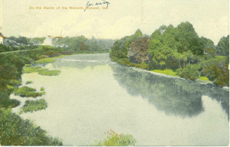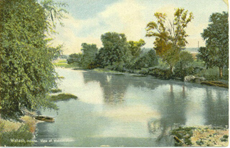Elisabeth Hamilton Friermood, born in 1903 in Marion, was a children’s librarian at the Marion Public Library from 1925 to 1928 before moving to Ohio. She then became a children’s librarian for the Dayton Public Library from 1930 to 1942. During her life, she wrote eighteen books, mostly fiction, about life in the late 1800s in Indiana and settings across the Midwest. Topics in her novels range from the Underground Railroad to the Spanish-American War to pioneer life in small towns. She personifies the Wabash, making it an essential element in the raising of children in The Wabash Knows the Secret, while it is nostalgic landmark symbolizing home in Hoosier Heritage. A few of her other novels set in Indiana include Doc Dudley’s Daughter, Whispering Willows, and The Wild Donahues, though they do not necessarily deal with the environment or nature.
Hoosier Heritage is a story of pioneer life in Richvalley, an area west of Wabash, Indiana. The family takes a covered wagon out west, a plan to keep one daughter from marrying Wingo, a Native American, though Indiana is their true home.
Most of the novel is about the daughter Julie and her homesickness for the beloved Wabash that she grew up on. “That good old Wabash, the river that meant home folk, familiar fields, woods, and pastures, summer picnics and spring floods; the river that meant home and Wingo to Julie, that meant Indiana to every Hoosier; the river that was a part of every Hoosier’s heritage” (96).
She describes the origin of the river’s name from the Miami Indian term Oubache, meaning “water over white stones” (42). Others began saying it, and eventually it was called the Wabash. Because of its importance to neighboring communities, the Wabash was named after many places and areas as the following passage explains:
“Did you ever think of all the things we got around here named Wabash?” Julie asked as they left the river. “There’s the Wabash River, Wabash County, South Wabash, the city of Wabash, the Wabash and Erie Canal, and Wabash Street there in town.” (41)
Besides the Wabash River, Julie spends much time in the fields and adjacent woods, especially in her favorite season, spring. “[T]here’s nothing as pretty as the Indiana countryside in April. Look at the green of those new leaves. Keeps on being this warm, the Johnny-jump-ups will be up. As a young thing I did love to go to the woods and gather Johnny-jump-ups!” (81).
Julie’s thoughts on the beauty of the Indiana landscape overwhelm her as she tries to imprint a picture in her mind to remind her of its beauty and of her true home while she’s adapting to a new land in Missouri. “She hesitated at the window, as though trying to fill her eyes with the landscape, trying to fill them with enough of the sight to last her a year…. How could she bear to leave these Indiana fields…?” (86).
Though the family forces Julie on the road to start a new home, she defies her father wishes to go farther west and stays with her sister in Missouri. Becoming independent, she starts her own school and is loved by all in the town. She falls in love with a prestigious doctor and the Missouri land, overpowering her love for Indiana.
However, she keeps her engagement promise to Wingo and reluctantly returns to Indiana when her year away has ended. Friermood historically documents the lighting of Wabash in 1880 when Julie arrives back just in time to see the lighting of the streets of the first city in the world with electricity (206). “What won’t be happening next in this world? Steam engines for trains, and now electricity for lights. Wonder if they’ll ever be able to make lights for houses that way?” (207).
Julie is amazed by the technology as well as by nature, once again. “Spring that year was extra-beautiful…. Indiana was trying its best to win her back, trying to say to this wandering Hoosier, ‘Nothing like this in Missouri, Julie. Just look at my apple blossoms, just see that redbud tree’” (215). The beautiful Wabash, the blossoming trees, and the expansive fields once meant home to her as she tries to “hang onto this Hoosier heritage” (218), but without her family there and with news that Wingo married another woman, she feels displaced and decides to start a new life in Missouri.
 
The captivating Wabash River also became an important element in Friermood’s next novel The Wabash Knows the Secret. In this tale about finding the grandfather’s buried treasure, the Wabash River is a part of the characters’ everyday lives. The “deliciously cool water of the Wabash” is a social place for the family (31), a getaway to nature, and a spiritual guide.
As the main character Henrietta grows up along the Wabash, she learns about her family’s past and of her grandfathers’s suspicious death. Before he died, however, he hid his treasured “wheat money” somewhere by the river but never had the chance reveal its location to his family. He always told his granddaughter, “Only the Wabash knows the secret” (33). She begins spending more and more time by the water and hopes that if she is patient, the river will tell her the secret. Through the change of the seasons, its dynamic character is a new adventure each day:
The river was all there: the laughing urgency of the current in spring; the languid laziness in summer, interspersed by the thunder of a quick summer storm; the sparkling clear water of a nippy fall day reflecting color, color, color; the howling of the winter’s wind over water choked with ice…. (232)
Another secret the Wabash would keep is a train wreck that is swept down the river, drowning the boxes, crates, and crew:
Now she knew that the river gave forth the roar: a roar of defiance at its confining banks. It was a floating torrent of water, raging down between the two bands as though seeking quick escape…. The current carried the bales swiftly; then one would catch on a rock and turn on end, swirl about and be caught in a crosscurrent, then go plunging down the middle of the river again. (64)
The night before Henrietta’s grandfather was murdered he wrote a poem about the Wabash and “the peace of flowing water,” contrasting to the raging torrent of water from above (71). Its “clean, pure sweetness” renewed her spirit and body whenever she went bathing. “She put back her head to survey the green laciness of the tress bending over her, like friendly guardians of her seclusion. Here she felt that she belonged to herself alone, to herself, to God, and to the river, her great clean, wonderful river” (125).
Grandma Melinda also describes the spiritual role of the river, asking Henrietta, “Don’t you know that your love for that river is really your love for God? For God is in that river as surely as He is in you…and the comfort God has brought you through that river will never leave you” (139-40). Later she finds symbolism of the river in Psalms and Revelation, explaining how humans should prosper with nature: “And he shall be like a tree planted by the rivers of water, that bringeth forth his fruit in this season; his leaf also shall not wither” (141).
The final secret of the Wabash, revealed to the father when his daughter is deathly ill, is the secret of living, portrayed by the movement and path of the river:
For the Wabash has a job to do, and that is, to get down to the Ohio, then to the Mississippi, the Gulf of Mexico, and the Atlantic Ocean; and no matter what happens to hinder or hamper it, it just goes over or under or around any obstacle that comes in its path and accomplishes what it set out to do, its current swifter because of the hindrances. (238)
Through dynamic descriptions of the Wabash and how it impacts her Hoosier characters, Elisabeth Hamilton Friermood portrays nature vividly through nostalgic beauty and hidden secrets of the land.
--JMP
Sources:
“Authors Among Us.” Ravenstone Press. Oct. 9, 2005. <http://www.ravenstonepress.com/libwritrf.html>.
“BRD/RCD Catalogue.” Braille Institute Library Services. Oct. 9, 2005. <http://www.braillelibrary.org/forourpatrons/bibliographies/brd_rcd_catalog.pdf>.
Friermood, Elisabeth Hamilton. Hoosier Heritage. Garden City, NY: Doubleday & Company, Inc., 1954.
---. The Wabash Knows the Secret. Garden City, NY: Doubleday & Company, Inc., 1951.
“Indiana Authors.” Wabash Carnegie Public Library. Oct. 10, 2005. <http://wabash.lib.in.us/indianaauthors.html>.
“RootsWeb.” MyFamily.com. Oct. 26, 2005. <http://ssdi.rootsweb.com/cgi-bin/ssdi.cgi?lastname=friermood>.
Images:
"Wabash County Postcards and Photos." Wabash County, Indiana Geneology. Dec. 7, 2005. <http://www.rootsweb.com/~inwabash/postcards/postcards.html>.
Links:
Lighting of Wabash - Electricmuseum.com
Official Wabash, IN Website
|




